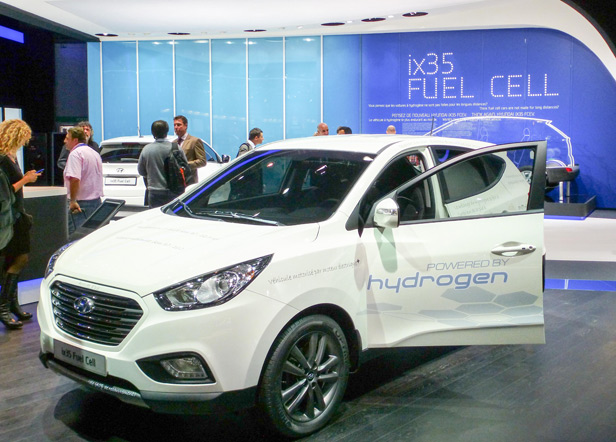Hydrogen Cars: A Dream That Won’t Die

By the mid-2000s, the dream of hydrogen-powered cars had faded in the face of stubborn practicalities like the lack of charging stations and the inefficiency of fuel cells. But as the auto industry wrestles with the limitations of battery-powered electric vehicles, the dream lives on. That is apparent at the Paris Auto Show.
When the show opened last month, battery-driven electric vehicles stood front and center (see “Renault and Others Debut Electric Cars at Paris Show”). But hydrogen-fuel-cell vehicles were also omnipresent. Show visitors could test-drive seven fuel-cell cars from leading automakers (including an SUV that Hyundai plans to begin leasing this winter), and a bevy of snazzy concept cars conjured up visions of a hydrogen-fueled future.
Automakers are showing new interest because key problems with fuel cells—their limited capacity to convert hydrogen to electricity and their susceptibility to freezing—have largely been overcome in recent years. At the same time, the first mass-produced electric vehicles based on batteries—the fuel cell’s technological rival for the zero-emissions mantle—have seen sales slow because their range remains disappointing and their prices high.
Even Nissan, which leads the global electric-vehicle market with its Leaf subcompact and has vowed to sell 1.5 million battery-powered vehicles by 2016 with corporate partner Renault, is showing a powerful fuel-cell SUV as a concept car in Paris. The company’s strategy reflects widely held views in the automotive industry, according to consultancy KPMG. Of the 200 executives polled in its 2012 Global Auto Executive Survey, those predicting that electric-car buyers of 2025 will prefer a fuel cell outnumbered those backing battery technology by 25 percent.
“Automakers believe in the capability of the fuel-cell vehicle,” says Kevin See, a senior analyst for Boston-based consultancy Lux Research. “There are no issues with range anxiety, making it a zero-emission option with the requisite performance to serve a broader consumer base.”
The fuel-cell cars at the Paris show deliver many times the Nissan Leaf’s 73-mile EPA-rated range. Hydrogen gas crammed into a carbon-fiber tank at 700-bar pressure—the current industry standard—can take Hyundai’s ix35 fuel-cell EV 365 miles. And Toyota boasts 435 miles of driving for its FCV-R fuel-cell EV concept sedan.
Nissan has not posted a range estimate for its TeRRA fuel-cell concept SUV. But in the face of public complaints from Leaf buyers disappointed by deteriorating mileage, it’s easy to see why fuel-cell technology would appeal (see “Don’t Drive Your Leaf Too Much”).
Renewed enthusiasm for hydrogen-powered cars is not just related to range, according to Gerald Killmann, Toyota’s director for powertrain R&D in Europe. In addition to settling real concerns over crucial issues such as cold-weather driving and rapid fueling, Toyota has greatly reduced the size of its fuel-cell system in recent years.
The fuel-cell stack in the FCV-R is approximately half the size and weight of the previous-generation stack developed in 2008 per kilowatt of output. Killmann says the fuel-cell sedan that Toyota plans to begin marketing in 2015 in Japan, North America, and Europe will be technically similar to the FCV-R. Similarly, Hyundai has downsized its drivetrain by running its fuel-cell stack on ambient air, thus eliminating the need for noisy, bulky, power-sapping compressors.
What is not yet ready for prime time is the fuel-cell EVs’ cost. Killmann says the FCV-R would cost close to 100,000 euros ($130,000) to produce today. Toyota hopes to cut costs at least in half by 2015 by developing all the components in-house—as it did with its hybrid drive.
See notes that fuel-cell vehicles have another crucial hurdle to overcome: the dearth of hydrogen fueling stations. There are currently no more than 280 worldwide, and many are not publicly accessible, according to Ulrich Buenger, coördinator for H2Moves, a 20-million-euro fuel-cell demonstration project funded by the European Union. Boosting their numbers will be pricey, since hydrogen filling stations cost around a million euros to install.
Buenger predicts that the cost of hydrogen stations will decline towards 300,000 euros, the price of a natural-gas pump, with each one installed—a process that is accelerating in Europe. Germany has 14 hydrogen stations open to the public, and a public-private collaboration announced early this year aims to roll out 36 more by 2015—enough to link most cities. Denmark laid out a comparable plan this spring. And on Friday, global chemicals producer Air Products announced plans to build two hydrogen filling stations in London, which would give the city a total of five.
Such plans are missing in the United States, though, where a U.S. Department of Energy website lists just seven public stations nationwide—all of them in California.
There is one big reason to be optimistic that this could change, says Buenger—an abundant supply of natural gas flowing from hydraulic fracturing (or fracking) wells, which provides a ready source of hydrogen. “There is already more and more interest in fuel-cell technology because of the new natural-gas resources,” he says.
Keep Reading
Most Popular
Large language models can do jaw-dropping things. But nobody knows exactly why.
And that's a problem. Figuring it out is one of the biggest scientific puzzles of our time and a crucial step towards controlling more powerful future models.
How scientists traced a mysterious covid case back to six toilets
When wastewater surveillance turns into a hunt for a single infected individual, the ethics get tricky.
The problem with plug-in hybrids? Their drivers.
Plug-in hybrids are often sold as a transition to EVs, but new data from Europe shows we’re still underestimating the emissions they produce.
Stay connected
Get the latest updates from
MIT Technology Review
Discover special offers, top stories, upcoming events, and more.